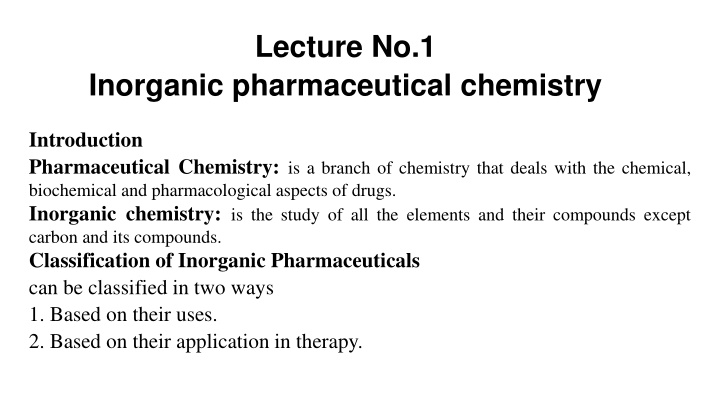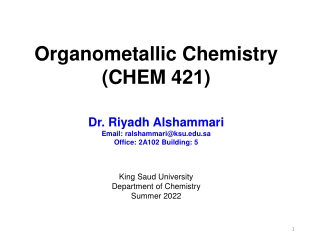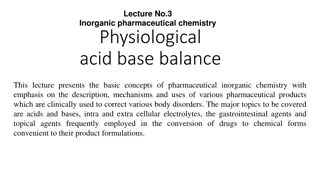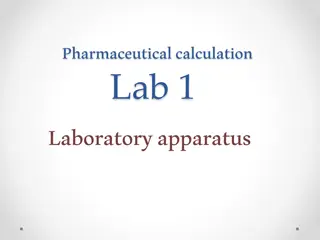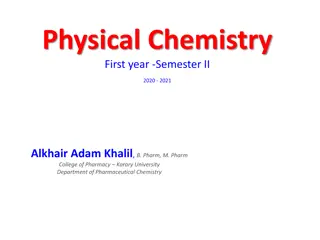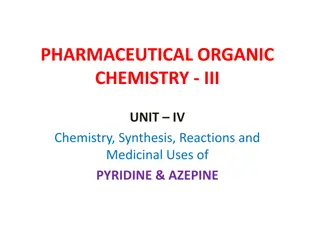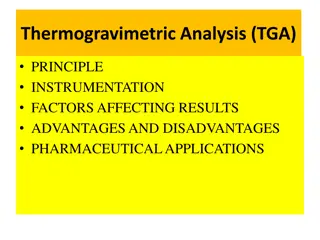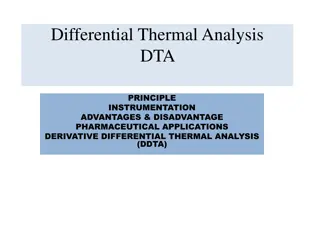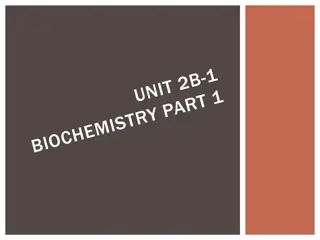Inorganic Pharmaceutical Chemistry: Introduction and Importance
Inorganic Pharmaceutical Chemistry delves into the chemical, biochemical, and pharmacological aspects of drugs, excluding carbon compounds. This branch of chemistry plays a crucial role in drug development, classification, and therapeutic applications such as treating acidosis, alkalosis, acne, and more. The uses of inorganic pharmaceuticals range from medicinal purposes to acting as pharmaceutical aids, reagents, and analytes in pharmaceutical analysis. Understanding the electronic structure of atoms and subatomic particles is fundamental in comprehending inorganic pharmaceuticals.
Download Presentation

Please find below an Image/Link to download the presentation.
The content on the website is provided AS IS for your information and personal use only. It may not be sold, licensed, or shared on other websites without obtaining consent from the author.If you encounter any issues during the download, it is possible that the publisher has removed the file from their server.
You are allowed to download the files provided on this website for personal or commercial use, subject to the condition that they are used lawfully. All files are the property of their respective owners.
The content on the website is provided AS IS for your information and personal use only. It may not be sold, licensed, or shared on other websites without obtaining consent from the author.
E N D
Presentation Transcript
Lecture No.1 Inorganic pharmaceutical chemistry Introduction Pharmaceutical Chemistry: is a branch of chemistry that deals with the chemical, biochemical and pharmacological aspects of drugs. Inorganic chemistry: is the study of all the elements and their compounds except carbon and its compounds. Classification of Inorganic Pharmaceuticals can be classified in two ways 1. Based on their uses. 2. Based on their application in therapy.
Importance of Inorganic Pharmaceuticals Inorganic pharmaceuticals are useful in any of the following ways. 1. Useful medicinally for their therapeutic purpose. Example: Astringents and antimicrobials etc. 2. Useful as pharmaceutical aids. Example: Bentonite, talc etc. 3. To change the reaction of body fluid. To acidify or alkalis. Example: Antacids, alkalis, mineral acids. 4. Replacing or replenishing the normal content of body fluids. Example: Sodium, potassium, calcium, chloride, phosphate ions etc. 5. Useful as reagents to carry out the reactions. Example: Catalysts (platinum, nickel) oxidizing and reducing agents (lithium aluminum hydride). 6. Useful in Pharmaceutical analysis. Example: Titrants such as potassium permanganate .. etc. Ali Albakaa 2
Classification based on their applications (therapeutic classification): Acidosis: sodium chloride, potassium chloride and others. Alkalosis: sodium chloride, potassium chloride. Acne: sulphur and its compounds. Allergic diseases: magnesium thiosulphate. Anaemia: iron compounds. Anoxia: Oxygen. Arthritis: sodium aurothiomalate. Asphyxia: Oxygen. Athlete s foot (Tinea pedis): sodium pyrophosphate. Boils: magnesium sulphate. Burns: silver nitrate, oxygen, zinc peroxide. Carbuncles: magnesium sulphate. 3 Ali Albakaa
Various uses of inorganic pharmaceuticals Abrasives: Dibasic calcium phosphate. Absorbents: Calcium carbonate. Acidifiers: Dilute hydrochloric acid. Adsorbents: Bismuth subcarbonate, Bismuth subnitrate. Alkalizers: Sodium citrate. Anesthetics: Nitrous oxide. Antacids: Aluminum hydroxide gel, Calcium carbonate, Magnesium carbonate. Anthelmintics: Ammoniated mercury, Sodium antimony tartrate. Antibacterial: Yellow mercuric oxide (ophthalmic). Anticonvulsants: Potassium bromide. .ets Ali Albakaa 4
Electronic Structure of Atoms Subatomic Particles and their properties Atomic number = Z = #e = #p (e =electron=0.0006 amu , p= proton=n=neutron=1.009 amu) Atomic mass = A = mp + mn - neutral atom: #e = #p - ion: Na+ , Cl-, #e #p - isotope : the number of neutrons varies. ?6 Atomic Orbitals s, p, d, &f Atomic Orbital filling applying Hund s rule and stability considerations 1.Every orbital in a sublevel is singly occupied before any orbital is doubly occupied. 2.All of the electrons in singly occupied orbitals have the same spin (to maximize total spin). 3.Only two electrons can occupy one orbital and they must have different spin states, + spin and spin e.g. Cr and Cu with z= 24 and 29 respectively 12 ,?6 13 ,?6 14, ?1 3 1 ,?1 2 ,?1 Ali Albakaa 5
The Periodic Law Electronegativity, definition and order. Ali Albakaa 7
Quantum Numbers : Representation of Atomic Orbitals The relation of a particular electron to the nucleus can be described through a series of four numbers, called the Quantum Numbers. -The first (n) describe the energy(1,2,3,4) (Principle quantum number) shell =(K,L,M,N). -The second (l) describe the shape (Angular momentum quantum number) (l =0,1,2,3,= s,p,d,f). -The third (ml) orientation of the orbital (magnetic quantum number) (ml =2l +1). -The fourth (ms) represents the "spin" of the electron (spin quantum number = 1/2). Ali Albakaa 8
10 Ali Albakaa
nS nP 1 2 3 4 5 6 7 H He Ne (n-1) d Ar Kr Xe Rn (n-2) f the quantum theory helps to explain the structure of the periodic table. n - 1 indicates that the d subshell in period 4 actually starts at 3 (4 - 1 = 3). Ali Albakaa 11
Writing electron configuration Li 1s2 2s1 C 1s2 2s2 2p2 O 1s2 2s2 2p4 Ne 1s2 2s2 2p6 S Ne10 3s2 3p4 Every element is different. - The number of protons determines the identity of the element. - The number of electrons determines the charge. - The number of neutrons determines the isotope. - All chemistry is done at the electronic level (that is why electrons are very important). - Electronic configuration is the arrangement of electrons in an atom; These electrons fill the atomic orbitals. Ali Albakaa 12
Properties within a group of elements r generally the same . * the major differences include in quantitative. Ionization energy: amount of energy to remove electron from gaseous atom . In period( raw) ionization energy increase within move from left to right but it contrast in group. It decrease with descending in group. Atomic radius: * period decrease Atomic radius within going from left to right(increase A.#, n value constant) .b more p in the nucleus higher electrical force pulls e(s) closer to nucleuses Group increase Atomic radius down the group or by increase n value( increase atomic #). valence e(s) radius at higher electron levels and not bonund as tightly to the nucleus protons they radius shield (pushed away) by other e(s) in inner levels Electronegativity: the ability of an atom in a molecule to attract shared e(s) to itself. * any period increase electronegativity from left to right. In group decrease electronegativity from top to bottom. Except VIIIA(inert gas). The most electronegative element is F and the least electronegative element is Francium (Fr) (IA). Ali Albakaa 13
Ali Albakaa 14
Electronic Structure of Molecules , , n, *, * Columbic attraction, electron electron Repulsion and nuclear repulsion Covalent; sharing of electron pairs Ionic; electrostatic interaction Orbital Hybridization- It involves mixing of atomic orbitals to provide a new set of degenerate orbitals having different spatial orientations and directional properties than the original atomic orbitals. Examples using Be, B and C including shapes and properties. The effect of ligand strength and the magnetic properties of the complex in determining shape e.g. octahedral, tetrahedral or square planar. Types of Bonding Interactions Ionic, involves ionization. e.g. sodium and calcium chlorides Covalent, involves sharing e. e.g. hydrogen, chlorine, carbon, hydrocarbons, phosphorus, carbon dioxide and hydrogen cyanide. Coordinate Covalent Bonding, involves sharing pair (e)s e.g. in boron trifluoride etherate. Q: What determines the nature of a bond? Ali Albakaa 15
Hydrogen Bonding Hydrogen bonding is a weak secondary interaction usually intramolecular and also intermolecular. It explains some of the unusual properties of water such as its relatively high boiling point. It is also important in describing the structures of proteins and nucleic acids. To form a H-bond, there must exist a hydrogen atom attached directly to one of the three atoms F, O or N. These atoms have high electronegativities. Van der Waals Forces Van der Waals forces are weak intermolecular forces to explain important phenomena including halogens and hydrocarbons as well as drug receptor. These interactions depend on masses and distance between molecules. Ali Albakaa 16
Other types of Interactions Polar interactions as well as induced dipole interactions are weak forces. However, they are important in explaining some properties of compounds as well as drug receptor interactions and the relative stability of some isomers. A Polar Molecule : The center of the overall negative charge on the molecule does not coincide with the center of overall positive charge on the molecule. The molecule can be oriented such that one end has a net negative charge and the other a net positive charge, i.e. the molecule is a dipole. A nonpolar molecule : Has no charges on the opposite ends of the molecule Or, has charges of the same sign on the opposite ends of the molecule , Molecule is not a dipole Polarisation Apart of the extreme cases of pure covalent bonding of homonuclear diatomic molecules and pure ionic bonding between GI and GVII atoms, these is always varying degrees of ionic or covalent character described in terms of polarity. The later depends on: 1. polarisabilty, highest for cations of high q/r. 2. polarising power, highest for anions of high q/r. 3. dipole moment, difference in electronegativities. 17 Ali Albakaa
Coordination Compounds Metallic cations, especially the transition metals are able to form stable compounds with additional anions or molecules with lone pair(s) of electrons (ligands), to form complexes. The maximum number of sites of the central metal-occupied is called the coordination number. The metal ion and its associated ligands is called the complex ion. The later with its counter ions is called the coordination compound. The stability of a complex depends on the metal ion and the basicity of the ligand, Lewis s concept. Ligands can be bi-dentate, tri-dentate, tetra-dentate, hexa-dentate or octa-dentate. Bonding in Complexes The valence bond theory is used to obtain a quantitative picture of bonding in complexes. The theory uses the idea of hybridization of the central metal atomic orbitals. The orientation of the five d orbitals of the metal in a complex is made of two sets. The d x2-y2 and dz2 orbitals are oriented along the axes of the Cartesian coordinate system. The other three; dxy, dyz and dxz are directed between the axes. Ali Albakaa 18
Ali Albakaa 19
Octahedral Complexes, 1-3 electrons For transition metals containing 1-3 electron in the d orbital e.g Cr+3 complexing with six cyano, CN- ions to form [Cr(CN)6]-3. Chromium (III) is a d3 ion; that is it contains 3 electrons in the in its 3d valance orbital. These electrons are unpaired and occupy the three off-axis d orbitals, thus leaving two d, one s and 3p orbitals empty for bonding with six cyano groups. If these six orbitals hybridize six equivalent orbitals are formed and will be occupied by the six lone pairs of electrons donated by the six cyano ligands. Cr24 Ar18 4S2 3d4 4p Cr+3 Ar18 4S3d3 4p 6 ( N C ) Ali Albakaa 20
Octahedral Complexes, 4-6 electrons When four or more electrons in the outer d orbital, for example complexes formed with iron(III) which is a d5 ion, the normal ground state arrangement of electrons use different orbitals for bonding. Fe26 Ar18 4S2 3d6 Fe+3 Ar18 4S 3d5 4p 4d In hexa-aquo iron(III) which is a high spin complex, with similar magnetic moment as the free ion, hybridization of six orbitals (tow 4d, one 4s, and three 4p) called outer orbital hybridization, sp3d2 instead of the usual sp3d2 hybridization. If the water molecules in hexa-aquo iron(III) complex ion are replaced with cyano groups, the hexacyanoferrate (III) ion results which has lower magnetic moment, a low spin complex. This is a result of the high magnetic field of the cyano groups of sufficient strength to repel the electrons in the two d orbitals which directly oppose the approaching ligands. The electrons become paired with those in the other d orbitals. Pairing with the six orbitals of the ligands will result in a low spin octahedral complex. Fe+3 Ar18 4S 3d5 4p 21 Ali Albakaa
Complexes with 7-9 d electrons Transition metal ions with seven, eight, or nine d electrons generally have coordination number of 4 which leads to either a square planar or a tetrahedral arrangement of the ligands. The strength of the ligand and the formation of high and low spin complexes may be predicative of the type of hybridization and therefore the geometry of the complex. For example a d8 ion complexing with a ligand having a relatively weak electrostatic field has no d orbitals available for bonding. However, the ligands can bond through the four sp3hybrid orbitals formed on the metal to give a tetrahedral complex. A strong ligand will force the metal into a low spin state and a square planar resulting from dsp3 hybridization will be formed. The complex has one vacant d orbital. Ali Albakaa 22
Complexes and Chelating Agents Chelating agents are important aspects of pharmacy, drug therapy. They have much efficacy in the treatment of heavy metal poisoning for elements such as lead, arsenic, mercury and iron. Chelating agents are important in treatment of metabolic disorders where metals such as iron and copper are accumulated in abnormal amounts in various tissues. Examples of important chelating agents include EDTA, BAL, penicillamine and deferoxamine. Calcium Disodium salt of EDTA It is a mixture of the dihydrate salt. It is a white crystalline granules or powder. It is odorless, slightly hygroscopic and has a faint saline taste. It is stable in air, soluble in water with pH between 6.5 and 8.0. It is used in the treatment of heavy metal poisoning especially plumbism (lead) and Cu, Ni, Cd, Zn, Cr & Mn but not for mercury, arsenic or gold. An increase in the excretion of metal in the urine by (500ug/liter/24hr or greater for Pb) is an indication of poisoning (toxicity). It induces hypocalcaemia states (low serum Ca). Doses are (intravenous) I.V. or (intramuscular) I.M. of 75mg/kg of body weight. Preparation; a solution containing 200mg/ml for injection. Ali Albakaa 23
Disodium edetate is a white crystalline powder which is soluble in water and has pH of 4.0- 6.0. It is used in treatment related to hypercalcemia including occlusive vascular disease and cardiac arrhythmias. It is not useful for dissolution of urinary calculi. Doses; IV injections of 50mg/kg of body weight. Preparation; 150mg/ml for injection. Ali Albakaa 24
Dimercaprol (BAL) is a colorless of mercaptan-like odor. It competes with enzymes containing sulfhydryl groups (responsible for oxidation-reduction) for the metals causing poisoning. The mercaptides formed are excreted in the urine. BAL is of value in the treatment of arsenic or gold poisoning and early mercury poisoning, within a few hours. Dose: in severe arsenic or gold poisoning, 3.0mg/kg is given six times a day for two days, four times a day on the third day, then twice daily on the next ten days. For early mercury poisoning, 5.0mg/kg followed by 2.5mg/kg twice daily for ten days. Preparations: I.M. injection of 100mg/ml in peanut oil. 25 Ali Albakaa
(CH3)2-C(SH)- CH(NH2)-COOH Penicillamine It is a white crystalline powder having characteristic odor. It is freely soluble in water with pH of (4.5-5.5). Penicillamine is used for treatment of poisoning of many metal including lead, iron, mercury and gold. Penicillamine is used for treatment of hepatolenticular degeneration (degeneration of the brain associated with increased levels of copper and Wilson s disease) which is associated with elevated levels of copper in tissues including; eye, liver, brain and kidney. Penicillamine is used in the treatment of gold dermatitis. Penicillamine is used in the treatment of cystinurea, the presence of crystals of cystine in urea. Dose: 250mg capsules given four times a day. Preparations: Cuprimine capsules containing 250mg of penicillamine for oral administration. The effectiveness of penicillamine as compared to is attributed: 1. its ability to resist metabolic inactivation by an oxidase since it doesn't have a hydrogen on the beta carbon atom. 2. its sulfhydryl group ability to convert Cu+2 to Cu+, with the formation of a tetrahedral rather than a square planar complex which has less affinity in competition with the tissue proteins containing SH groups of oxidative value. 26 Ali Albakaa
Deferoxamine is for acute iron deficiency. It forms an octahedral complex with Fe+3. It has no affinity to divalent ions including Fe+2. Deferoxamine is not soluble in the gastrointestinal tract so oral administration is not effective. It is produced by streptomyces as a ferric Fe(III)complex. After chemical removal of the iron, the chelating agent is purified as the methyl sulphonate salt. Dose: IV or IM injections of 1.0g followed by 0.5g every 4-12 hours. Preparations: Desferal ampules containing 500mg of the lyophilized powder for injection. Ali Albakaa 27
Ali Albakaa 28
